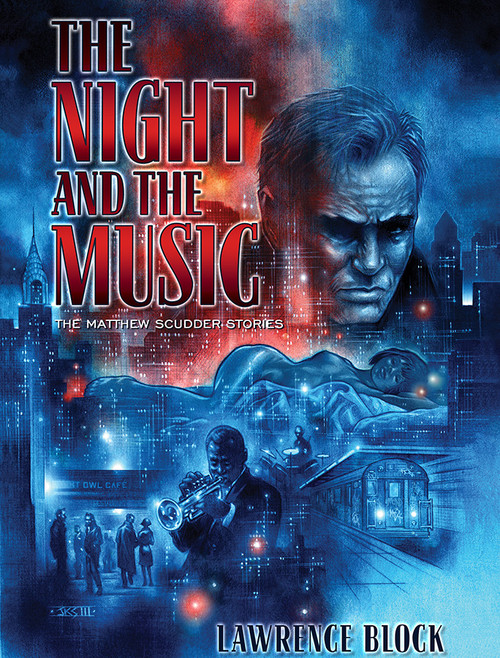Dust jacket illustration by Edward Miller.
Jack McDevitt has been a Sherlock Holmes fan since he was a teenager, although he reports that Holmes-style mysteries, whodunits, are not his favorite style. Jack encountered Gilbert Chesterton’s Father Brown tales a few years later and they ultimately became the prime influence in his science fiction. The issue with Father Brown was never a question of who committed the murder, but rather what in heaven’s name is going on here?
Why does an astronaut, in “Cathedral,” sacrifice her life to collide with an asteroid that she knows poses no threat to the Earth? Why does a scientist who’s designed an actual working AI in “The Play’s the Thing,” hide what’s he’s done? How is it that the lives of two people working at Moonbase in “Blinker” depend on a quasar?
In “Lucy,” Jack shows us why sending automated vehicles to explore the distant outposts of the solar system may not be a good idea. And in “Searching for Oz,” an alternate history story, how things might have been if SETI had gotten what it was looking for. He describes our reaction in “Listen Up, Nitwits,” when a voice begins speaking to us, apparently from Jupiter, in Greek. And in “The Lost Equation,” a Holmes adventure, we discover who really was first to arrive at e=mc2.
Jack also provides two episodes, “Maiden Voyage” and “Waiting At the Altar,” from Priscilla Hutchins’ qualification flight; and an effort by a sixteen-year-old Alex Benedict, in the title story with his uncle Gabe and Chase Kolpath’s mom, Tori, who are trying to understand why a brilliant radio entertainer, lost in the stars when his drive unit suffered a malfunction, never said goodbye.
These and thirteen other rides into odd places await the reader.
Limited: 1000 signed numbered copies
From Publishers Weekly:
“Fans of classic science fiction will enjoy this collection of 24 short stories that cover familiar genre themes such as the search for alien life and the implications of time travel in plain but effective prose. McDevitt, best known for his Alex Benedict and Priscilla Hutchins series (both represented by entries here), excels at conjuring an alternate world, even within the confines of the short story format.”
From Booklist:
“Of particular interest to McDevitt’s readers are two stories from his well-known Academy series, detailing Priscilla Hutchins’ qualification flight when she first became a starship pilot, in addition to several other stories set in the Academy universe. McDevitt’s fans will welcome this collection.”
From Paul Di Filippo at Locus Online:
“[A Voice in the Night] reaches back to 1986 for one entry, but predominantly features publications from very recent years, showcasing McDevitt’s mature talents in this narrative range.
“In their themes and novums, these tales diversely inhabit almost the whole breadth of modern SF, but share certain qualities. They are all upbeat without being Pollyanna-ish; respectful of the rigors of solid science without being close-minded or unimaginative; and told in old-school, straightforward linear fashion, a kind of Ur-narrative that never really loses its punch or utility. Lively yet not without gravitas and poetry, these stories embody the core values of SF.”
Table of Contents:
- Introduction: Jack McDevitt, History Builder, by Martin L. Shoemaker
- Searching for Oz
- The Law of Gravity Isn’t Working on Rainbow Bridge
- The Adventure of the Southsea Trunk
- Combinations
- It’s a Long Way to Alpha Centauri
- Lucy
- Listen Up, Nitwits
- Midnight Clear
- The Lost Equation
- Blood Will Tell, Co-written with Tom Easton
- Blinker
- Friends in High Places
- Maiden Voyage
- Waiting at the Altar
- The Play’s the Thing
- Oculus
- Good Intentions, with Stanley Schmidt
- Molly’s Kids
- Ships in the Night
- The Pegasus Project
- The Last Dance
- Cathedral
- Weighing In
- A Voice in the Night
Searching for Oz (excerpt)
Solomon Martin would probably not have been part of the biggest scientific breakthrough of the twentieth century, and maybe ever, had he not read The War of the Worldsin 1907 when he was in the sixth grade. Radio was in its early stages at the time, the Martians got into his head, and he built his own crystal receiver two years later and aimed it at the red planet. He was of course disappointed by the unrelenting silence. His system, he decided, just wasn’t good enough. He needed something better.
The Adventure of the Southsea Trunk (excerpt)
Henry Cable was, if anything, true to his word. When he told people he was going to do something, they could, as the saying goes, put it in the bank. So alarm bells went off when he failed to show up for the Victorian Club luncheon, at which he’d been the featured speaker. He not only failed to show up, he didn’t warn anyone. The liaison, Mrs. Agatha Brantley, was left to make apologies as best she could.
For Cable, it was unheard of.
He didn’t answer his phone. And when, after the luncheon had staggered to a desultory end and a worried Mrs. Brantley went to his house, she got no answer. At that point she called us. “Something’s terribly wrong,” she told the watch officer. There was of course nothing we could do. So she took charge. She got on the phone, located Cable’s maid service, and persuaded them to come early and open up. The place had been ransacked. And there was no sign of Cable. She called us again.
LUCY (excerpt)
“We’ve lost the Coraggio.” Calkin’s voice was frantic. “The damned thing’s gone, Morris.”
When the call came in, I’d been assisting at a simulated program for a lunar reclamation group, answering phones for eleven executives, preparing press releases on the Claymont and Demetrius projects, opening doors and turning on lights for a local high-school tour group, maintaining a cool air flow on what had turned into a surprisingly warm March afternoon, and playing chess with Herman Mills over in Archives. It had been, in other words, a routine day. Until the Director got on the line.
Denny Calkin is a small, narrow man, in every sense of the word. And he has a big voice. He was a political appointment at NASA, and consequently was in over his head. He thought well of himself, of course, and believed he had the answers to everything. On this occasion, though, he verged on hysteria. “Morris, did you hear what I said?” He didn’t wait for an answer. “We’ve lost the Coraggio.”
LISTEN UP, NITWITS (excerpt)
The first time we heard the Voice, the world seemed to be coming apart. U.S. and Chinese fleets were making runs at each other in the western Pacific, two more Middle Eastern nations had announced nuclear breakthroughs, and Al Quaida seemed to have discovered a fresh mother lode of suicide bombers.
It was mid-morning California time, and I’d just arrived at the SETI Institute at the Carl Sagan Center. It was my day off, but the real world seemed kind of scary just then. The Institute was a good place to hide out, so that’s where I went.
Canfield in the Morning, our cable news show, was going on about how we were on the verge of World War III unless things changed radically. They ran clips of U.S. troops preparing for action in Taiwan, Chinese leaders issuing warnings, and an American carrier launching aircraft. There were also unconfirmed reports that U.S. and Chinese warships had exchanged fire in the Gulf of Tonkin. Palo Alto was putting up a new city hall, which was to be a glass and steel structure with a rotating tower, suggestive of a brilliant future. I’d driven past it coming in that morning, and I wondered why we were bothering. It felt as if everything was about to come tumbling down.
THE LOST EQUATION (excerpt)
Emil Kohler was a guy who laughed a lot, chased women, generally enjoyed life, and in his spare time picked up a Ph.D. in physics. But on that gray afternoon, when he walked into a London café, carrying a briefcase, he did not look happy. We hadn’t seen each other since he’d left Baltimore for a teaching position at Brunel University. “Henry,” he said, “it’s good to see you.” We shook hands and he slipped into a chair. “How long has it been?”
“About four years.”
“Well, I see you’ve been moving along. Congratulations.” He dug into the briefcase and produced a copy of my new book, The Philosophy of Friedrich Nietzsche. I was still trying to forget my earlier one, an unhappy analysis of George Bernard Shaw which had sold about fifty copies. I’d said good things about Shaw but apparently even he didn’t like it.
BLINKER (excerpt)
The second shock hit as Ward stepped off the ladder onto lunar rock.
“Look out.” Amy’s startled voice rang in his earphones.
The ground swayed. Dust rose. He looked up at her.
“Twice in one day,” she said. “Is it always like this?”
“Didn’t used to be.” Ward had lived here almost five years, before they’d automated everything, and moved everyone back to Moonbase. Or Earth. He didn’t think there’d been more than a dozen quakes during that whole time.
“Glad to hear it. Maybe we need to do a seismic survey.
“I hate to put it this way, but it’s your problem now.” As of noon, Amy Quinn had become the new director of the NASA/Smithsonian Farside Observatory. Ward was officially on his way home.
MAIDEN VOYAGE (excerpt)
For Priscilla Hutchins, it was the experience she’d always dreamed of: her qualification flight, a mission that would take her to seven planetary systems, and ultimately to her pilot’s license.
The most exciting destination, she thought, would be Fomalhaut, a white main sequence dwarf, about twice the size of Earth’s sun, and sixteen times brighter. But that wasn’t what had captured her imagination. Fomalhaut’s system contained the first extrasolar planet actually seen through a telescope. It was a giant world, three times the size of Jupiter. But the real news came when we’d actually arrived in the system: the largest satellite in its family of moons was home to one of the alien constructs that eventually became known as the Great Monuments. Put in place by an unknown entity thousands of years ago. By the time of her qualification flight, a total of eleven had been discovered, scattered around the Orion Arm. They are magnificent sculptures, set on moons and asteroids and small planets, and occasionally simply placed in their own orbits. The first was discovered long before we had achieved interstellar flight. On Iapetus. It depicts a lizard-like female creature believed to be a self-portrait of the sculptor. And it was a major factor in restarting a long-stalled space program.
Since she’d been a little girl, Hutch had wanted to see the Iapetus monument, but she’d had to settle for turning out the lights in her living room and looking up at a virtual representation. She’d felt a kinship with the alien creature gazing placidly across that destitute landscape at the ringed planet, which was permanently frozen on the horizon. Never rising, never setting. Priscilla had sat on her sofa sipping orange juice. She didn’t want to pretend to be at the site. She wanted to be there. To touch the stone image. To trace with her fingers the alien characters cut into its base.
No one had ever deciphered their meaning.
- artists_list:
- Edward Miller
- authors_list:
- Jack McDevitt
- binding:
- Hardcover
- book_case:
- None
- book_edition:
- Deluxe Limited
- book_length:
- 464 pages
- book_type:
- Collection
- country_of_manufacturer:
- United States
- isbn:
- 978-1-59606-880-3
- is_subpress:
- Yes
- manufacturer:
- Subterranean Press
- print_status:
- Out of Print
- year:
- 2018











